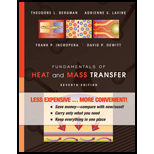
Concept explainers
The estimate of the power required to maintain a brass plate at
The power required to maintain a brass plate at a temperature of
Given:
The temperature of the brass plate is
The temperature of the saturated water is
Formula Used:
From the thermo-physical properties of the saturated water, the temperature of the saturated water is given by,
From the thermo-physical properties of the saturated water, the value of enthalpy of vaporization is given by,
From the thermo-physical properties of the saturated water, the density of the water liquid is given by,
From the thermo-physical properties of the saturated water, the density of the saturated vapor is given by,
From the thermo-physical properties of the saturated water, the expression for the dynamic viscosity of the liquid is given by,
From the thermo-physical properties of the saturated water, the Prandtl number of the saturated liquid is given by,
From the thermo-physical properties of the saturated water, the specific heat of the liquid is given by,
From the thermo-physical properties of the saturated water, the surface tension of the liquid is given by,
The expression for the nucleate boiling heat flux(power) at
The expression to determine the heat flux is given by,
Calculation:
The power required to maintain a brass plate at
The power required to maintain the boiling plate at
The value of the constant
The critical heat flux of the plate operating at
The critical heat flux of the plat operating at
Conclusion:
Therefore, the power required to maintain a brass plate at a temperature of
Want to see the full answer?
Check out a sample textbook solution
Chapter 10 Solutions
Fundamentals of Heat and Mass Transfer
- Consider a steam power plant that operates on a simple, ideal Rankine cycle and has a net power output of 45 MW. Steam enters the turbine at 7 MPa and 500°C and is cooled in the condenser at a pressure of 10 kPa by running cooling water from a lake through the tubes of the condenser at a rate of 2000 kg/s. Show the cycle on a T-s diagram with respect to saturation lines, and determine The thermal efficiency of the cycle,The mass flow rate of the steam and the temperature rise of the cooling waterarrow_forwardTwo reversible heat engines operate in series between a source at 600°C, and a sink at 30°C. If the engines have equal efficiencies and the first rejects 400 kJ to the second, calculate: the temperature at which heat is supplied to the second engine, The heat taken from the source; and The work done by each engine. Assume each engine operates on the Carnot cyclearrow_forwardA steam turbine operates at steady state with inlet conditions of P1 = 5 bar, T1 = 320°C. Steam leaves the turbine at a pressure of 1 bar. There is no significant heat transfer between the turbine and its surroundings, and kinetic and potential energy changes between inlet and exit are negligible. If the isentropic turbine efficiency is 75%, determine the work developed per unit mass of steam flowing through the turbine, in kJ/kgarrow_forward
- Homework#5arrow_forwardMember AB has the angular velocity wAB = 2.5 rad/s and angular acceleration a AB = 9 rad/s². (Figure 1) Determine the magnitude of the velocity of point C at the instant shown. Determine the direction of the velocity of point C at the instant shown. Determine the magnitude of the acceleration of point C at the instant shown. Determine the direction of the acceleration of point C at the instant shown. A 300 mm WAB α AB B 500 mm 0=60° y 200 mmarrow_forwardYou are asked to design a unit to condense ammonia. The required condensation rate is 0.09kg/s. Saturated ammonia at 30 o C is passed over a vertical plate (10 cm high and 25 cm wide).The properties of ammonia at the saturation temperature of 30°C are hfg = 1144 ́10^3 J/kg andrv = 9.055 kg/m 3 . Use the properties of liquid ammonia at the film temperature of 20°C (Ts =10 o C):Pr = 1.463 rho_l= 610.2 kf/m^3 liquid viscosity= 1.519*10^-4 kg/ ms kinematic viscosity= 2.489*10^-7 m^2/s Cpl= 4745 J/kg C kl=0.4927 W/m Ca)Calculate the surface temperature required to achieve the desired condensation rate of 0.09 kg/s( should be 688 degrees C) b) Show that if you use a bigger vertical plate (2.5 m-wide and 0.8 m-height), the requiredsurface temperature would be now 20 o C. You may use all the properties given as an initialguess. No need to iterate to correct for Tf. c) What if you still want to use small plates because of the space constrains? One way to getaround this problem is to use small…arrow_forwardIf you have a spring mass damper system, given by m*x_double_dot + c*x_dot + kx = 0 where m, c, k (all positive scalars) are the mass, damper coefficient, and spring coefficient, respectively. x ∈ R represents the displacement of the mass. Let us then discuss the stability of the system by using Lyapunov stability theorem. Consider the system energy as a candidate Lyapunov function shown in the image. Discuss the positive definiteness of V (x, x_dot). Derive the Lyapunov rate of this system (i.e., V_dot ), and discuss the stability property of thesystem based on the information we gain from ̇V_dot .arrow_forwardIn class, two approaches—Theorems 1 and 2 below—are discussed to prove asymptotic stability of asystem when ̇V = 0. Show the asymptotic stability of the system given in Eq. (1) by applying Theorem 1. Show the asymptotic stability of the system given in Eq. (1) by applying Theorem 2.arrow_forwardHomework#5arrow_forwardarrow_back_iosSEE MORE QUESTIONSarrow_forward_iosRecommended textbooks for you
 Principles of Heat Transfer (Activate Learning wi...Mechanical EngineeringISBN:9781305387102Author:Kreith, Frank; Manglik, Raj M.Publisher:Cengage Learning
Principles of Heat Transfer (Activate Learning wi...Mechanical EngineeringISBN:9781305387102Author:Kreith, Frank; Manglik, Raj M.Publisher:Cengage Learning
 Principles of Heat Transfer (Activate Learning wi...Mechanical EngineeringISBN:9781305387102Author:Kreith, Frank; Manglik, Raj M.Publisher:Cengage Learning
Principles of Heat Transfer (Activate Learning wi...Mechanical EngineeringISBN:9781305387102Author:Kreith, Frank; Manglik, Raj M.Publisher:Cengage Learning